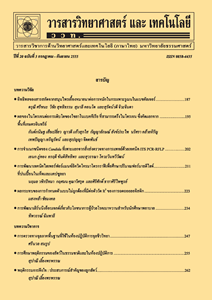ความคิดเห็นของชุมชนเกี่ยวกับปัญหาการกัดเซาะชายฝั่งของประเทศไทย
Main Article Content
Abstract
บทคัดย่อ
การศึกษาความคิดเห็นของชุมชนเกี่ยวกับปัญหาการกัดเซาะชายฝั่งของประเทศไทยในครั้งนี้ มีวัตถุประสงค์เพื่อรวบรวมเอกสารจากงานวิจัยต่าง ๆ ที่เกี่ยวข้อง เพื่อศึกษาสถานการณ์และแนวโน้มการกัดเซาะชายฝั่ง ความคิดเห็นของชุมชนในด้านสิ่งแวดล้อม เศรษฐกิจ และสังคม รวมถึงการดำเนินการป้องกันและการแก้ไขปัญหา ผลการศึกษาพบว่าระหว่าง พ.ศ. 2546-2554 มีชายฝั่งทะเลถูกกัดเซาะ จำนวน 282 พื้นที่ โดยมีความยาวชายฝั่งที่ถูกกัดเซาะ ประมาณ 652.17 กิโลเมตร จังหวัดที่มีการกัดเซาะมากที่สุดในฝั่งอ่าวไทย คือ จังหวัดนครศรีธรรมราช (53.46 กิโลเมตร) ส่วนทางด้านฝั่งอันดามัน จังหวัดที่มีการกัดเซาะมากที่สุด คือ จังหวัดพังงา (53.20 กิโลเมตร) ชุมชนที่ให้ข้อมูลมีความคิดเห็นไปในทิศทางเดียวกัน กล่าวคือ การกัดเซาะชายฝั่งส่งผลกระทบโดยตรงต่อระบบนิเวศบริเวณชายฝั่ง ได้แก่ ป่าชายหาด ป่าชายเลน ปะการัง หญ้าทะเล และปริมาณและความหลากหลายของทรัพยากรสัตว์น้ำ สำหรับในด้านเศรษฐกิจชุมชนมีความเห็นว่าการกัดเซาะชายฝั่งส่งผลต่อภาคธุรกิจโดยตรง ทำให้แหล่งท่องเที่ยวเกิดสภาพเสื่อมโทรมและสูญเสียแนวชายหาดที่มีทัศนียภาพสวยงาม สำหรับด้านสังคม ทำให้ชุมชนริมฝั่งทะเลได้รับผลกระทบ ก่อให้เกิดการอพยพย้ายถิ่น การสูญเสียวิถีชีวิตชุมชนดั้งเดิม การสูญหายของประเพณีและวัฒนธรรมท้องถิ่น และความสัมพันธ์ระหว่างเครือญาติและเพื่อนบ้านลดลง การแก้ไขปัญหาการกัดเซาะชายฝั่งที่ผ่านมาส่วนใหญ่มักเน้นการใช้โครงสร้างทางวิศวกรรม ได้แก่ กำแพงป้องกันคลื่น รอดักทราย เขื่อนกันคลื่น เป็นต้น ซึ่งมักจะก่อให้เกิดผลกระทบต่อพื้นที่ข้างเคียง ดังนั้นในการแก้ไขปัญหาการกัดเซาะชายฝั่งควรมีการศึกษาลักษณะทางกายภาพของชายฝั่งแต่ละพื้นที่เป็นอันดับแรก ทั้งในเรื่องลักษณะภูมิประเทศ ลักษณะทางธรณีวิทยา ความลาดชันของชายหาด คลื่นและกระแสลม เป็นต้น รวมไปจนถึงการให้ชุมชนได้เข้ามามีส่วนร่วมในการแก้ไขปัญหา เพื่อช่วยกันแก้ไขปัญหาได้ตรงจุดและเหมาะสมกับสภาพพื้นที่มากยิ่งขึ้น
คำสำคัญ : การกัดเซาะชายฝั่ง; ผลกระทบ; ความคิดเห็นของชุมชน
Abstract
The objective of this academic article is to review the published articles related to the problem, situation and trend of coastal erosion in Thailand. Additionally, the details of this article include the opinion of coastal community in terms of environmental, economic and social impacts caused by coastal erosion. Moreover, the management strategies that had previously been operated are also reviewed. This study reviews that, during 2003-2011, 652.17 kilometers of coastal lines which covered 282 communities nearby shoreline had been faced with erosion problems. In the part of the Gulf of Thailand, Nakhon Si Thammarat was identified as the longest shoreline (53.46 kilometers) affected by coastal erosion, whilst Phang Nga was listed as the longest erosion area (53.20 kilometers) in Andaman coast. The people lived nearby the coastal zone presented that the erosion strongly affects coastal ecosystems such as forest beach, mangrove forests, coral reefs, seagrass habitats and biodiversity of aquatic animals. The erosion directly destroyed attractive beach scenery resulted to reduce the numbers of tourists which consequently negatively influenced to the benefits on business sectors. In high erosion zones, there was obvious evidence that people had been moved from the community to live in higher safety locations. This review also confirmed that unique local tradition and culture had been changed due to erosion problems. Consequently, there was less relationship between people in the community. The current management strategies, i.e. sea wall, groin and breakwater etc., have been focused on how to construct engineering structures to reduce the level of erosion. Although, the hard structures can solve erosion in the constructed areas, the erosion will be generated or happened in neighbor community due to changing of water current. Therefore, in order to provide the suitable management strategies, the research focused on topography, geography, slope of the beach, water current, wind, as well as the community opinion are seriously desired.
Keywords: coastal erosion; impact; opinion of the community

